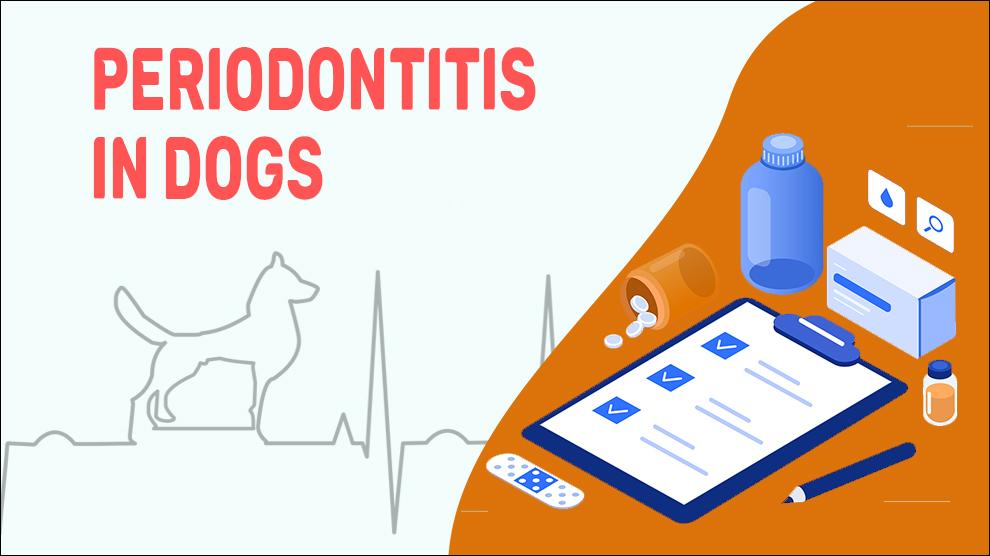What Is Periodontitis In Dogs?
The most common dental condition in dogs is periodontal disease (Periodontitis). Periodontal disease results due to bacterial buildup and subsequent infection in the teeth and gums. Periodontal disease involves inflammation of the alveolar bone and periodontal ligament, ultimately causing loss of attachment (gingival recession, periodontal pocketing, and bone tissue destruction).
More than 75% of dogs have some sort of dental disease by the time they are three years old. Gingivitis is considered to be a first warning sign of imminent periodontal disease.
Whenever a dog consumes its food, the chewing process (breakdown of carbohydrates) leaves behind a sticky substance and within 24 hours, this sticky substance begins to solidify forming a plaque with the salts (calcium and phosphate ions) found naturally in your dog’s saliva. Dental plaque is an active, complex biofilm of the extremely heterogeneous and poly-microbial community (interactive microenvironment) that grow in a mass of exopolysaccharides called plaque matrix.
In its starting stages, the plaque is mostly organic and it is made up of bacteria, mineral salts, organic matter, food particles, and serum. The accumulated plaque continues to mineralize and ultimately transforms into tartar (dental calculus). This is formed just at or above the gum margins (supragingival) and forms below the gum line on the surfaces of the tooth root (subgingival).
Tartar buildup can lead to infection, inflammation (gingivitis), periodontal disease, and even loss of teeth. Most commonly, plaque-associated gingivitis is found as edematous, erythematous tissue that halos the teeth.
Symptoms Of Periodontitis In Dogs
- Bleeding gums
- Red or swollen gums
- Bad breath (halitosis)
- Difficulty or pain with chewing
- Pus/mucous along the gum line, in nasal discharge
- Loss of appetite
- Lethargy
Treatment Options For Periodontitis In Dogs
- Dental cleaning procedures.
- Dental scaling - Conventional hand scalers or ultrasonic cleaning equipment to scrape off the plaque and tartar from the tooth surfaces.
- Gingival curettage - Elimination of inflamed, infected, damaged, or necrotic tissue from the gingival sulcus at the gingival margin around a tooth.
- Application of antibiotic medications to resolve gum infections.
- Gingivectomy - Removal of excessive gingival tissues.
- Gingivoplasty – Elimination of diseased soft tissue from the wall of a periodontal pocket and recontouring of the gum tissue.
- Periodontal surgery – A procedure performed for deeper cleaning and treatment of the root of the tooth by opening the gum to expose the tooth. Bone growth stimulants, Slow-release antibiotics, and sealants will be added to encourage attachment and healing.
Home Remedies For Periodontitis In Dogs
- Dental wipes, chew toys for dogs, treats or oral rinses such as Peridex, or Nolvadent may also help avoid bleeding gums and delay plaque/tartar.
- Calendula Lotion soothes sores and ulcerations inside the dog's mouth.
- Provide Dental diet-approved kibble and treats. The Hills T/D, the Purina DH, and The Royal Canin Dental diet are Veterinary exclusive diets.
Prevention Of Periodontitis In Dogs
- Prevention of plaque/tartar accumulation is the simplest way of preventing periodontitis.
- Dental wipes treats, chew toys or oral rinse may also help delay or decrease tartars.
- Use veterinary oral health council-approved dog toothpaste or pet-safe enzymatic toothpaste that is specially formulated for dogs at least 2-4 times each week.
- Exclusively formulated dental diets are available with established tartar-reducing ingredients.
- Confirm with the Veterinary Oral Health Council website for products listed for plaque control to reduce the accumulation of plaque and/or tartar.
Affected Dog Breeds Of Periodontitis
Maltese, Poodle, Yorkshire Terrier, Pomeranian, Lhasa Apso, Cavalier King Charles Spaniel, Shih Tzu
There is no breed disposition.
Additional Facts For Periodontitis In Dogs
1. Causes
- Microbial homeostasis - Plaque forms in a structured way and has a functionally-organized, species-rich microbial community that is relatively stable over time.
- The dominant bacterial species in dental plaque are Fusobacteriumcanifelinum and Porphyromonas crevioricanis.
- The most common genus belongs to Porphyromonas, Fusobacterium, and Capnocytophaga.
2. Stages:
- Stage 1: Faint signs, gum inflammation (Gingivitis) – normal alveolar margins, teeth supporting structures are good and attachment loss is yet to begin.
- Stage 2: Preliminary stage periodontitis - < 25% of the tooth’s attachment to the supporting structures is lost (measured by Dental x-rays or clinical probing).
- Stage 3: Intermediate periodontitis - 25% -50% of the tooth’s attachment to supporting structures is lost.
- Stage 4: Periodontitis advanced stage - tooth attachments > 50% is lost.
3. Mortality:
There is no mortality associated with periodontitis documented yet.
4. Diagnosis:
- Routine dental exam
- Dental X-rays
5. Prognosis:
Stage 1 and Stage 2 periodontal disease prognosis are well provided that they receive the proper dental care. Moreover, the prognosis of Stage 3 dogs is also good if sophisticated dental procedures are performed. Prognosis is poor for Stage 4 of periodontal disease when more than 50% of the tooth’s support is lost.
When To See A Vet For Periodontitis In Dogs?
Time to visit the vet clinic for an examination, if you notice any of the following:
- Bad breath (halitosis)
- Bleeding/ Red or swollen gums
Food Suggestions For Periodontitis In Dogs
Foods to eat:
- Cooked chicken giblets (hearts, liver, gizzards)
- Bones (raw, not cooked)
- Fiber-rich fruits and vegetables
- Foods with fluoride including dehydrated soups
- Cheese, milk, plain yogurt, and other dairy products
- Dental diet-approved kibble and treats
Foods to avoid:
- Starchy foods that can get stuck in the mouth
- Chewy, sticky, and hard candy
- Crackers, Popcorn
- Rice and potato-based dental sticks
Conclusion
The accumulation of dental plaque prevention should be given top priority because it can lead to gingivitis and subsequently periodontal disease. They not only affect the oral health of dogs but the infection may be transported through the bloodstream to all parts of the body and can cause other systemic problems.

















